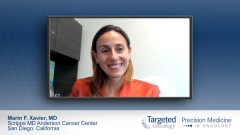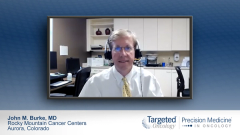
Loncastuximab for R/R DLBCL
An overview of the LOTIS-1 clinical trial and the rationale for the accelerated approval of loncastuximab for relapsed/refractory diffuse large B-cell lymphoma.
Episodes in this series

Marin F. Xavier, MD: Should we move on to loncastuximab? We know it’s a CD19, an antibody-drug conjugate. The drug that’s linked to it is an alkylator, is it not?
John M. Burke, MD: It’s a PBD dimer, so it’s pyrrolobenzodiazepine PBD dimer cytotoxin. That’s the drug in the antibody-drug conjugate.
Marin F. Xavier, MD: I thought for some reason that had alkylating properties.
John M. Burke, MD: I confess that I’m not sure. You might be right.
Marin F. Xavier, MD: It’s a newer payload that we’re not used to in our ADCCs [antibody-dependent cell cytotoxicities]. We’re more used to the MMAE [monomethyl auristatin E] and maybe MMAF [monomethyl auristatin F]. This is a new 1. Some of its toxicity relates to that payload. Why don’t you talk a little, John, about the LOTIS-1 trial. Then I’m going to try to nail down some of the other data that I’m getting a little foggy on because I haven’t looked at it in a couple of days.
John M. Burke, MD: There was a phase 1 trial in all comers with relapsed B-cell non-Hodgkin lymphoma that demonstrated activity. Then they did a phase 2 trial, which is now published. In the phase 2, the eligible patients had relapsed/refractory DLBCL [diffuse large B-cell lymphoma] and had received at least 2 prior therapies. It’s important to talk about the dosage. The way this drug was dosed in the phase 2 was 150 µg/kg IV [intravenous] every 3 weeks for 2 doses, but then you drop the dose to 75 µg/kg thereafter. It’s 2 doses, and they get 150 µg/kg every 3 weeks and thereafter it’s 75 µg/kg every 3 weeks, and the drug was continued for up to a year.
The efficacy results were an overall response rate of 48% and a CR [complete response] rate exactly half that, so it’s easy to remember: 24% CR and overall response rate 48%. It’s still fairly early, so we’re getting a little duration of response with longer follow-up. The last 1 I saw as a median was 13 months. It does appear to be effective in all groups. I stand corrected—it was 15 patients. I forgot the number earlier. Fifteen patients went on to receive CAR [chimeric antigen receptor] T-cell therapy after loncastuximab and had an overall response rate of 47%, and 9 patients got a stem cell transplant after loncastuximab.
The toxicities of the drug are to some degree a unique and, as you mentioned, probably related to that PBD dimer. One thing reported that no one quite knew what to make of were these elevated GGT levels, which were tracked on the study. That did not seem to correlate with real liver toxicity. My understanding is that the prescribing information does not recommend that we all follow GGT levels or act on GGT levels. That was just a phenomenon that was observed. Another unique toxicity was fluid retention and edema, which apparently can be a problem for some patients. It’s important to keep that in mind in managing folks. The anecdotes were that spironolactone does seem to have some benefit in helping control the edema. The other toxicities were basic cytopenias that we’re all used to dealing with: neutropenia, thrombocytopenia, anemia, and fatigue. Those were the main toxicities to be aware of. Particularly the fluid retention and edema are something to keep an eye out for those who are using the drug.
Marin F. Xavier, MD: Those are unique toxicities, and edema may have to do with the payloadbecause we know that other CD19 agents don’t have that.
John M. Burke, MD: That’s my understanding as well.
Marin F. Xavier, MD: That GGT issue is residual from how the studies were designed because that’s not something, in this country at least, we tend to measure. That’s a quirky thing about the toxicity and what made it into the package insert, which is a little different from what we do in regular clinical practice.
Transcript edited for clarity.








































